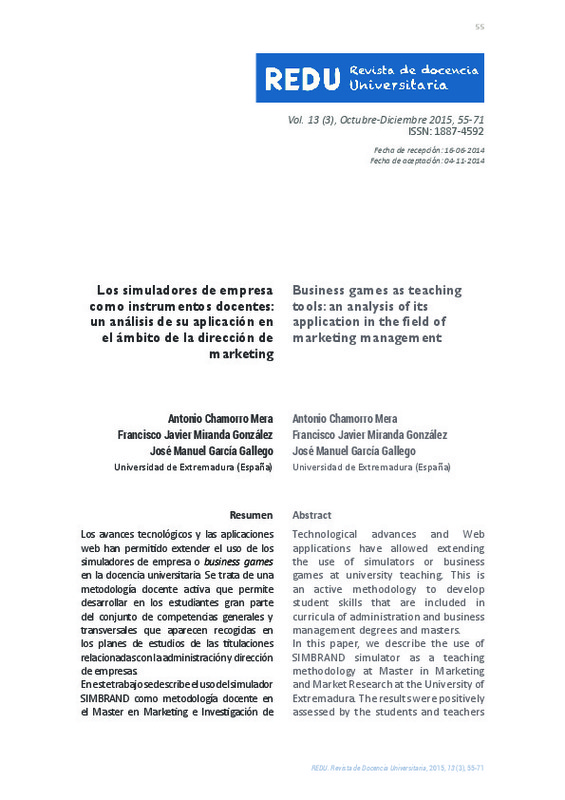Arias-Aranda, D. (2007). Simulating reality for teaching strategic management. Innovations in Education & Teaching International, 44, 3, 273-286. http://dx.doi.org/10.1080/14703290701486662
Arias, D., Haro, C. y Romerosa, M. M. (2010). Un enfoque innovador del proceso de ense-anza-aprendizaje en la dirección de empresas: el uso de simuladores en el ámbito universitario. Revista de Educación, 353, 707-721.
Blanco, M. y García, F. (2006). La eficacia de los juegos de empresas en el ámbito de la Dirección de Empresas. ICONO, 14 NºVIII
[+]
Arias-Aranda, D. (2007). Simulating reality for teaching strategic management. Innovations in Education & Teaching International, 44, 3, 273-286. http://dx.doi.org/10.1080/14703290701486662
Arias, D., Haro, C. y Romerosa, M. M. (2010). Un enfoque innovador del proceso de ense-anza-aprendizaje en la dirección de empresas: el uso de simuladores en el ámbito universitario. Revista de Educación, 353, 707-721.
Blanco, M. y García, F. (2006). La eficacia de los juegos de empresas en el ámbito de la Dirección de Empresas. ICONO, 14 NºVIII
Capobianco, M., Fialho, F.A.P., Cunha, C. J. y Niveiros, S. I. (2013). Business Games for Leadership Development: A Systematic Review. Simulation & Gaming, 44, 4, 523-543. http://dx.doi.org/10.1177/1046878112471509
Chang, J. (2003). Use of Business Simulation Games in Hong Kong. Simulation & Gaming, 34, 3, 358-366. http://dx.doi.org/10.1177/1046878103255876
Chang, J., Lee, M., Ng, K. L. y Moon, K. L. (2003). Business Simulation Games: The Hong Kong Experience. Simulation & Gaming, 34, 3, 367-376. http://dx.doi.org/10.1177/1046878103255877
Domínguez, M, Rodríguez-Pérez, F. J. y González-Sánchez, J. L (2007). Simulador MPLS para la Innovación Pedagógica en el área de Ingeniería Telemática. IEEE-RITA, 2 1, 27-34.
Faria, A. J. (1998). Business Simulation Games: Current Usage Levels: an Update. Simulation & Gaming, 29, 3, 295-308. http://dx.doi.org/10.1177/1046878198293002
Faria, A. J. y Wellington, W. J. (2004). A Survey of Simulation Game Users, Former-Users, and Never-Users. Simulation & Gaming, 35, 2, 178-207. http://dx.doi.org/10.1177/1046878104263543
Faria A. J. y Wellington, W. J. (2005). Validating business gaming: Business game conformity with PIMS findings. Simulation & Gaming, 36, 2, 259-273. http://dx.doi.org/10.1177/1046878105275454
Faria, A. J., Hutchinson, D., Wellington, W. J. y Gold, S. (2009). Developments in Business Gaming: A Review of the Past 40 Years. Simulation & Gaming, 40, 4, 464-487. http://dx.doi.org/10.1177/1046878108327585
Fernández March, A. (2006). Metodologías activas para la formación de competencias. Educatio Siglo XXI, 24, 35-56.
Fortmüller, R. (2009). Learning Through Business Games: Acquiring Competences Within Virtual Realities. Simulation & Gaming, 40, 1, 68-83. http://dx.doi.org/10.1177/1046878107308075
García-Carbonell, A. y Watts, F. (2007). Perspectiva histórica de simulación y juego como estrategia docente: de la guerra al aula de lenguas para fines específicos. IBÉRICA, 13, 65-84.
Garris R, Ahlers R., Driskell J. E. (2002). Games, Motivation and learning: A research and practice model, Simulation & Gaming, 33, No 4, 441-467. http://dx.doi.org/10.1177/1046878102238607
Gutiérrez, M., Romero, M. S. y Solórzano, M. (2011). El aprendizaje experiencial como metodología docente: aplicación del método Macbeth. Argos,28, 54.
Hernández, A. B. y Campa, F. (2010). Competencias y utilidades de los juegos de negocios para la gestión empresarial: una experiencia formativa. Revista Iberoamericana de Contabilidad de Gestión. Volumen VIII, 15.
Jaffe, E. D. y Nebenzahl, I. D. (1990). Group Interaction and Business Game Performance. Simulation & Gaming, 21, 2, 133-146. http://dx.doi.org/10.1177/1046878190212002
MEC (2006). Directrices para la elaboración de títulos universitarios de grado y máster. Ministerio de Educación y Ciencia. Madrid
Nevado, A. J. (2008). Construcción de un simulador docente. Revista Espa-ola de Física, 22, 1, 61-65.
Palés, J. L. y Gomar, C. (2010). El uso de las simulaciones en educación médica. TESI, 11, 2, 147-169.
Palmunen, L. M., Pelto, E., Paalumäki, A. y Lainema, T. (2013). Formation of Novice Business Students' Mental Models Through Simulation Gaming. Simulation & Gaming, 44, 6, 846-868. http://dx.doi.org/10.1177/1046878113513532
Rachman-Moore, D., Kennett, R. S. (2006). The Use of Simulation to Improve the Effectiveness of Training in Performance Management. Journal of Management Education, 30, 3, 455-476. http://dx.doi.org/10.1177/1052562905280099
Schank, R. C. (2002). Designing World-Class E-Learning: How IBM, GE, Harvard Business School and Columbia University Are Succeding at e-Learning. McGraw-Hill.
Snow, S., Gehlen, F., Green J. C. (2002). Different ways to introduce a business simula-tion: The effect on student performance, Simulation & Gaming, 33, 4, 526-532. http://dx.doi.org/10.1177/1046878102238617
Van Dam, N. (2004). The e-Learning Fieldbook. McGraw-Hill.
Wolfe, J. (1976). The effects and effectiveness of simulations in business policy teaching applications, Academy of Management Review, 47, 56-24. http://dx.doi.org/10.5465/amr.1976.4408663
Wolfe, J. y Box, T. M. (1988). Team Cohesion Effects on Business Game Performance. Simulation & Gaming, 19, 1, 82-98. http://dx.doi.org/10.1177/003755008801900105
Woolliscroft J. O., Calhoun J. G., Tenhaken J. D., Judge R. D. (1987). Harvey: the impact of a cardiovascular teaching simulator on student skill acquisition. Medical teacher, 9, 1, 53-7 http://dx.doi.org/10.3109/01421598709028980
[-]








